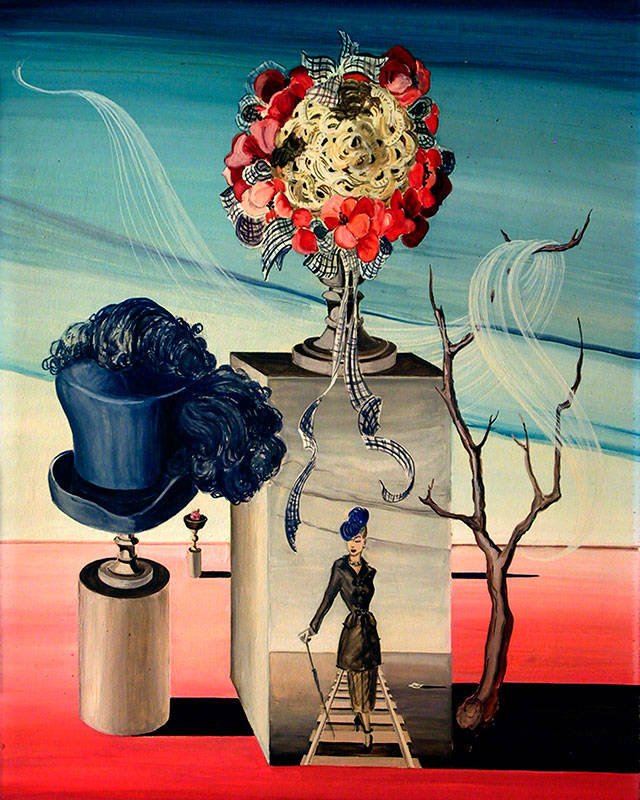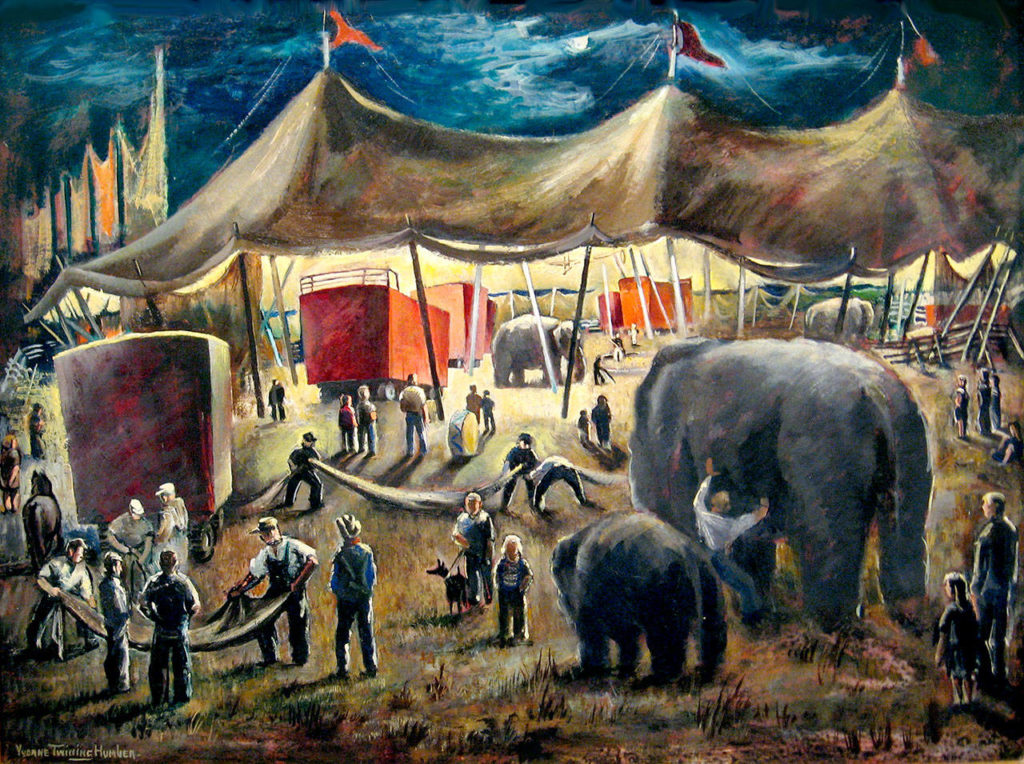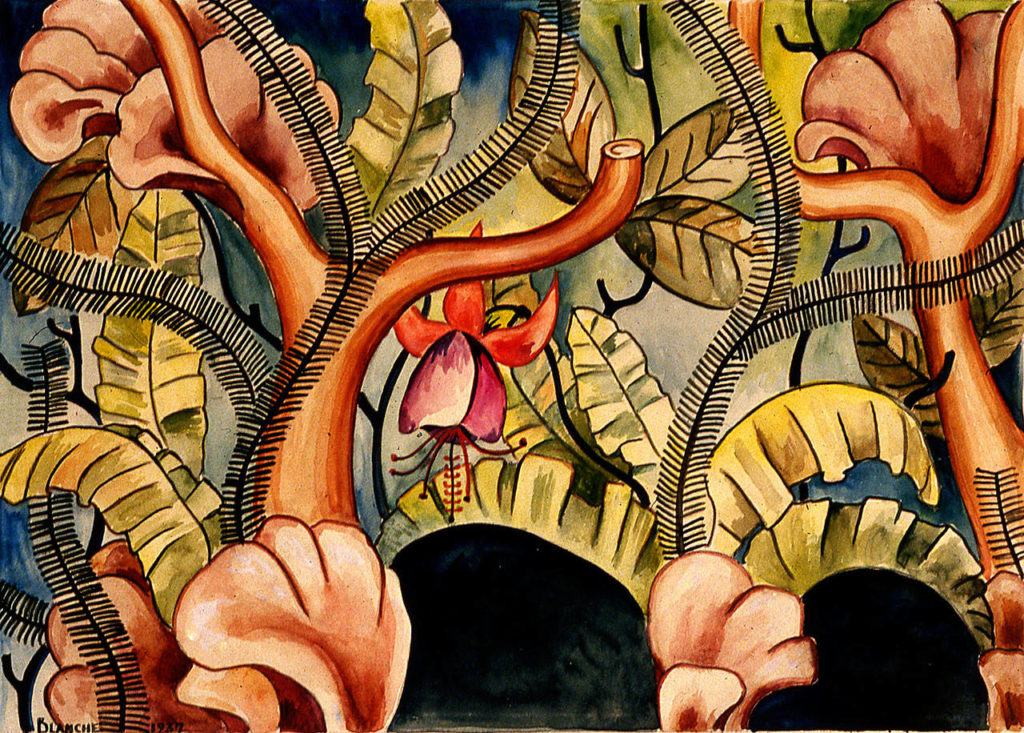One painter, Yvonne Twining Humber, exhibited with artists such as Georgia O’Keeffe and Edward Hopper.
The other, Blanche Morgan Losey, earned a degree in architecture from the University of Washington before turning to art with a style of hard-edged realism that earned her national attention.
Yet their work, produced from the 1930s to the 1950s, has remained largely unknown and rarely exhibited in recent years.
That’s one of the reasons that David Martin, curator at the Cascadia Art Museum in Edmonds, has long wanted to produce an exhibition of their works.
The show, “Drama and Design: Yvonne Twining Humber and Blanche Morgan Losey,” which opened last week, is on display through Sept. 30.
Humber moved to the Northwest in 1943. Her work was “pretty much the opposite” of what was being done regionally at the time, Martin said. It was an era dominated by Northwest artists such as Mark Tobey, Morris Graves and Guy Anderson.
“They all used water-based mediums, tempera and watercolors,” Martin said. Their work was influenced by Asian art and the color palette they used was grays, browns and silvers, he said.
There weren’t that many people doing strictly oil paintings and Humber’s style of realism, Martin said.
Her drawing abilities, technique and knowledge of the medium were infinitely better than those of her well-known peers, he said. “She was on a different level. But she was very shy. That’s the problem. She wasn’t a self-promoter.”
Humber was a very successful painter living on the East Coast, hired to work for the Works Progress Administration from 1935 to 1943. Her paintings travelled with the WPA all over the country.
When the Depression-era federal arts program disbanded in 1943, she was left trying to find ways to support herself, her mother and her aunt.
“Since the money stopped, they told her she had to get married to support them,” Martin said. At the time she was living in the The Berkshires in western Massachusetts.
A man living in Seattle, who had been part of the early wave of European refugees fleeing the Nazis, made a trip to the hilly area of Massachusetts where Humber was living.
He met Humber’s aunt, and in turn was set up with her niece. Despite a significant age difference, Humber’s aunt told her she was going to marry him. “It was because he owned a business and could financially take care of them,” Martin said.
They did marry. Humber came to Seattle, her mother soon followed. Her husband’s mother, a World War II concentration camp survivor, moved in as well. Humber “had her hands full with these two elderly women,” Martin said.
Humber had a solo show at the Seattle Art Museum in 1946.
In the 1950s, Humber gave birth to a girl who died of crib death as an infant, sending her into deep depression.
Then her husband, who had been diagnosed with cancer but never told her, died while they were on a trip in 1960. “She fell apart,” Martin said.
Her husband’s business was in debt. She had no income. She stopped painting and became a recluse.
Friends tried to help. They included two women, a couple, who helped her with her finances and taught her how to invest money.
Before he and his partner moved to Seattle, Martin had lived on the East Coast and was familiar with her work. Once here, he decided to look her up. “We found out no one remembered who she was,” Martin said.
They soon became close friends with Humber. She started painting again.
“As she got older, I told her what a pioneer she was,” Martin said. She responded in what he calls a typical “don’t brag about yourself” New England manner: “Oh, I’m just doing what I love to do.”
She died in 2004. Seattle’s Frye Art Museum organized a retrospective show of her work in 2007-08.
Part of the display of Losey’s work — the studies she completed for the Federal Theater Project of Seattle’s Negro Repertory Co. — has never before been part of a museum exhibition.
The fact they exist to be displayed in Edmonds came about through happenstance. She had died in 1981. Humber had suggested that Martin should look up Losey’s husband, then a widower.
Martin went and saw some of Losey’s work displayed in her home. Losey’s husband later left it to Martin to sell his wife’s work to benefit Seattle Children’s Hospital.
One day when Martin went to the house, he saw some things thrown into black garbage bags. Inside the bags were all the drawings she had done of the Negro Repertory Co. from the mid- to late 1930s. The collection, which included photos of the actors, was donated to the University of Washington’s Special Collections.
The studies are watercolors, providing a vivid color record of the stage sets and costumes, Martin said.
Losey grew up in Olympia and Tacoma. After graduating from the UW, she began working in interior design at Seattle’s Frederick & Nelson department store in the 1930s.
She joined Women Painters of Washington and had her works shown nationally, including in New York City.
In addition to displaying her work for the Federal Theater Project, the Cascadia show includes her work as a surrealist with a Northwest point of view, Martin said.
One untitled painting, a self-portrait, is of a woman in 19th-century clothing on a train track. “You see this woman trapped between today and the 19th century about to be run over,” he said.
Martin said he hopes people will take advantage of the opportunity to see the exhibit of the two women’s art.
“People will not have the opportunity to see these again for a long, long time,” he said.
Sharon Salyer: 425-339-3486 or salyer@heraldnet.com.
If you go
What: “Drama and Design: Yvonne Twining Humber and Blanche Morgan Losey”
Where: Cascadia Art Museum, 190 Sunset Ave., Edmonds
When: Through Sept. 30
Tickets: Adults $10, seniors $7, youth ages 5-18 $7, children 4 and younger free.
More: 425-336-4809 or www.cascadiaartmuseum.org
Lecture: Curator David Martin will lead a tour of the exhibit, providing personal stories of the artists, from 10 a.m. to noon July 22, Aug. 12 and Sept. 9.
Talk to us
> Give us your news tips.
> Send us a letter to the editor.
> More Herald contact information.



























